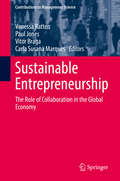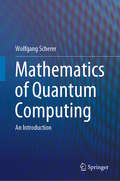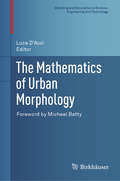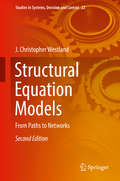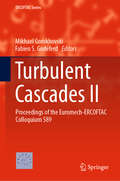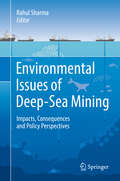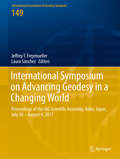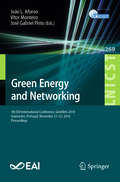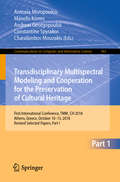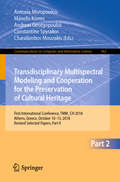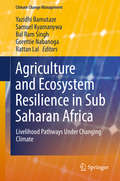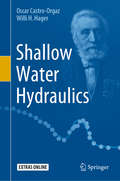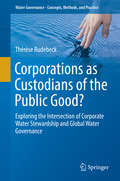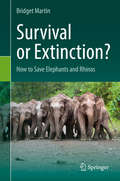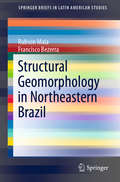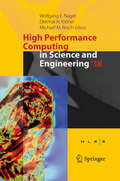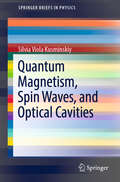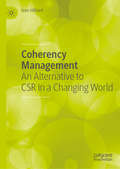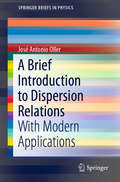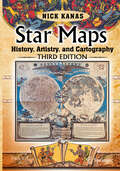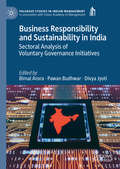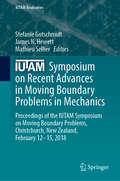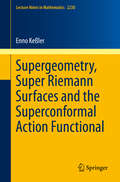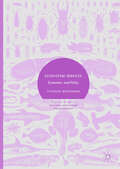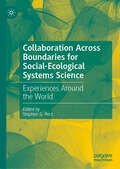- Table View
- List View
Sustainable Entrepreneurship: The Role Of Collaboration In The Global Economy (Contributions to Management Science)
by Paul Jones Vanessa Ratten Vitor Braga Carla Susana MarquesSustainable entrepreneurship focuses on how the environment is embedded within business practices. This book examines collaboration strategies and initiatives for sustainable entrepreneurs with a wide variety of partners, and demonstrates how they can be used to increase overall performance and achieve global competitiveness. Based on the latest empirical evidence from emerging economies, the book’s respective chapters address sustainability issues in connection with knowledge creation and learning, outsourcing, and the roles of universities, consultants, and the public sector.
Mathematics of Quantum Computing: An Introduction
by Wolfgang SchererThis textbook presents the elementary aspects of quantum computing in a mathematical form. It is intended as core or supplementary reading for physicists, mathematicians, and computer scientists taking a first course on quantum computing. It starts by introducing the basic mathematics required for quantum mechanics, and then goes on to present, in detail, the notions of quantum mechanics, entanglement, quantum gates, and quantum algorithms, of which Shor's factorisation and Grover's search algorithm are discussed extensively. In addition, the algorithms for the Abelian Hidden Subgroup and Discrete Logarithm problems are presented and the latter is used to show how the Bitcoin digital signature may be compromised. It also addresses the problem of error correction as well as giving a detailed exposition of adiabatic quantum computing. The book contains around 140 exercises for the student, covering all of the topics treated, together with an appendix of solutions.
The Mathematics of Urban Morphology (Modeling and Simulation in Science, Engineering and Technology)
by Michael Batty Luca D'AcciThis edited volume provides an essential resource for urban morphology, the study of urban forms and structures, offering a much-needed mathematical perspective. Experts on a variety of mathematical modeling techniques provide new insights into specific aspects of the field, such as street networks, sustainability, and urban growth. The chapters collected here make a clear case for the importance of tools and methods to understand, model, and simulate the formation and evolution of cities.The chapters cover a wide variety of topics in urban morphology, and are conveniently organized by their mathematical principles. The first part covers fractals and focuses on how self-similar structures sort themselves out through competition. This is followed by a section on cellular automata, and includes chapters exploring how they generate fractal forms. Networks are the focus of the third part, which includes street networks and other forms as well. Chapters that examine complexity and its relation to urban structures are in part four.The fifth part introduces a variety of other quantitative models that can be used to study urban morphology. In the book’s final section, a series of multidisciplinary commentaries offers readers new ways of looking at the relationship between mathematics and urban forms.Being the first book on this topic, Mathematics of Urban Morphology will be an invaluable resource for applied mathematicians and anyone studying urban morphology. Additionally, anyone who is interested in cities from the angle of economics, sociology, architecture, or geography will also find it useful."This book provides a useful perspective on the state of the art with respect to urban morphology in general and mathematics as tools and frames to disentangle the ideas that pervade arguments about form and function in particular. There is much to absorb in the pages that follow and there are many pointers to ways in which these ideas can be linked to related theories of cities, urban design and urban policy analysis as well as new movements such as the role of computation in cities and the idea of the smart city. Much food for thought. Read on, digest, enjoy." From the foreword by Michael Batty
Structural Equation Models: From Paths to Networks (Studies in Systems, Decision and Control #22)
by J. Christopher WestlandThis new edition surveys the full range of available structural equation modeling (SEM) methodologies. The book has been updated throughout to reflect the arrival of new software packages, which have made analysis much easier than in the past. Applications in a broad range of disciplines are discussed, particularly in the social sciences where many key concepts are not directly observable. This book presents SEM’s development in its proper historical context–essential to understanding the application, strengths and weaknesses of each particular method. This book also surveys the emerging path and network approaches that complement and enhance SEM, and that are growing in importance. SEM’s ability to accommodate unobservable theory constructs through latent variables is of significant importance to social scientists. Latent variable theory and application are comprehensively explained and methods are presented for extending their power, including guidelines for data preparation, sample size calculation and the special treatment of Likert scale data. Tables of software, methodologies and fit statistics provide a concise reference for any research program, helping assure that its conclusions are defensible and publishable.
Turbulent Cascades II: Proceedings of the Euromech-ERCOFTAC Colloquium 589 (ERCOFTAC Series #26)
by Mikhael Gorokhovski Fabien S. GodeferdGathering contributions by the most prominent researchers in a highly specialised field, this proceedings volume clarifies selected aspects of the physics of turbulent cascades and their statistical universalities under complex stationary and non-homogeneous conditions. Here, these conditions are induced by the presence of a gas/liquid interface, inertial particles, strong shear, rotation, MHD and stratification. By proposing different ways to model turbulence effects under these complex conditions, the book will be of considerable interest not only to academic researchers, but also to specialists and junior researchers in the domain of propulsion and power, as well as those whose work involves various applications related to atmospheric, oceanic and planetary physics.
Environmental Issues of Deep-Sea Mining: Impacts, Consequences and Policy Perspectives
by Rahul SharmaThis volume discusses environmental issues associated with deep-sea mining, with an emphasis on potential impacts, their consequences and the policy perspectives. The book describes the methods and technologies to assess, monitor and mitigate mining impacts on marine environments, and also suggests various approaches for environmental management when conducting deep-sea mining. The volume brings together information and data for researchers, contractors, mining companies, regulators, and NGOs working in the field of deep-sea mining. Section 1 highlights the various environmental issues and discusses methods and approaches that can help in developing environmentally sustainable deep-sea mining. Section 2 details the results and outcomes of studies related to impact assessment of deep-sea mining, and proposes methods for monitoring. Section 3 discusses the need and means for developing data standards and their application to deep-sea mining. Section 4 discusses the policies, approaches, and practices related to deep-sea mining, suggests formats for developing environmental impact statements (EIS) and environmental management plans (EMP), and describes national and international regulations for environmental management. Section 5 concludes the text by putting deep-sea economic activities into an environmental context and conducting techno-economic analyses of deep-sea mining and processing.
International Symposium on Advancing Geodesy in a Changing World: Proceedings of the IAG Scientific Assembly, Kobe, Japan, July 30 – August 4, 2017 (International Association of Geodesy Symposia #149)
by Jeffrey T. Freymueller Laura SánchezThese proceedings contain 23 papers, which are the peer-reviewed versions of presentations made at the Joint Scientific Assembly of the International Association of Geodesy (IAG) and the International Association of Seismology and Physics of the Earth’s Interior (IASPEI). The assembly was held from 30 July to 4 August 2017 in Kobe, Japan. The scientific assembly included seven symposia organized by IAG, and nine joint symposia, along with additional symposia organized by IASPEI. The IAG symposia were structured according to the four IAG Commissions and the three GGOS Focus Areas, and included reference frames, static and time-variable gravity field, Earth rotation and geodynamics, multi-signal positioning, geodetic remote sensing, and GGOS. The joint symposia included monitoring of the cryosphere, studies of earthquakes, earthquake source processes, and other types of fault slip, geohazard warning systems, deformation of the lithosphere, and seafloor geodesy. Together, the IAG and joint symposia spanned a broad range of work in geodesy and its applications.
Green Energy and Networking: 5th EAI International Conference, GreeNets 2018, Guimarães, Portugal, November 21–23, 2018, Proceedings (Lecture Notes of the Institute for Computer Sciences, Social Informatics and Telecommunications Engineering #269)
by José Gabriel Pinto Vítor Monteiro João L. AfonsoThis book constitutes the refereed post-conference proceedings of the 5th EAI International Conference on Green Energy and Networking, GreeNets 2018, held in Guimarães, Portugal, in November 2018. The 15 full papers were selected form 26 submissions and cover a wide spectrum of ideas to reduce the impact of the climate change, while maintaining social prosperity. In this context, growing global concern leads to the adoption of the new technological paradigms, especially for the operation of future smart cities.
Transdisciplinary Multispectral Modeling and Cooperation for the Preservation of Cultural Heritage: First International Conference, TMM_CH 2018, Athens, Greece, October 10–13, 2018, Revised Selected Papers, Part I (Communications in Computer and Information Science #961)
by Antonia Moropoulou Manolis Korres Andreas Georgopoulos Constantine Spyrakos Charalambos MouzakisThis two-volume set CCIS 961 and 962 constitutes the refereed post-conference proceedings of the First International Conference on Transdisciplinary Multispectral Modeling and Cooperation for the Preservation of Cultural Heritage, TMM_CH 2018, held in Athens, Greece, in October 2018.73 revised full papers of 237 submissions are included in these volumes. The papers of the first volume are organized in the following topical sections: the project of the rehabilitation of Holy Sepulchre’s Holy Aedicule as a pilot multispectral, multidimensional, novel approach through transdisciplinary and cooperation in the protection of monuments; digital heritage; novel educational approach for the preservation of monuments; resilience to climate change and natural hazards; conserving sustainably the materiality of structures and architectural authenticity; and interdisciplinary preservation and management of cultural heritage. And the papers of the second volume are organized in the following topical sections: sustainable preservation and management lessons learnt on emblematic monuments; cross-discipline earthquake protection and structural assessment of monuments; cultural heritage and pilgrimage tourism; reuse, circular economy and social participation as a leverage for the sustainable preservation and management of historic cities; inception – inclusive cultural heritage in Europe through 3D semantic modelling; heritage at risk; and advanced and non-destructive techniques for diagnosis, design and monitoring.
Transdisciplinary Multispectral Modeling and Cooperation for the Preservation of Cultural Heritage: First International Conference, TMM_CH 2018, Athens, Greece, October 10–13, 2018, Revised Selected Papers, Part II (Communications in Computer and Information Science #962)
by Charalambos Mouzakis Constantine Spyrakos Andreas Georgopoulos Manolis Korres Antonia MoropoulouThis two-volume set CCIS 961 and 962 constitutes the refereed post-conference proceedings of the First International Conference on Transdisciplinary Multispectral Modeling and Cooperation for the Preservation of Cultural Heritage, TMM_CH 2018, held in Athens, Greece, in October 2018. 73 revised full papers of 237 submissions are included in these volumes. The papers of the first volume are organized in the following topical sections: the project of the rehabilitation of Holy Sepulchre’s Holy Aedicule as a pilot multispectral, multidimensional, novel approach through transdisciplinary and cooperation in the protection of monuments; digital heritage; novel educational approach for the preservation of monuments; resilience to climate change and natural hazards; conserving sustainably the materiality of structures and architectural authenticity; and interdisciplinary preservation and management of cultural heritage. And the papers of the second volume are organized in the following topical sections: sustainable preservation and management lessons learnt on emblematic monuments; cross-discipline earthquake protection and structural assessment of monuments; cultural heritage and pilgrimage tourism; reuse, circular economy and social participation as a leverage for the sustainable preservation and management of historic cities; inception – inclusive cultural heritage in Europe through 3D semantic modelling; heritage at risk; and advanced and non-destructive techniques for diagnosis, design and monitoring.
Agriculture and Ecosystem Resilience in Sub Saharan Africa: Livelihood Pathways Under Changing Climate (Climate Change Management)
by Yazidhi Bamutaze Samuel Kyamanywa Bal Ram Singh Gorettie Nabanoga Rattan LalThis volume discusses emerging contexts of agricultural and ecosystem resilience in Sub Saharan Africa, as well as contemporary technological advances that have influenced African livelihoods. In six sections, the book addresses the sustainable development goals to mitigate the negative impacts on agricultural productivity brought about by climate change in Africa. Some of the challenges assessed include soil degradation, land use changes, natural resource mismanagement, declining crop productivity, and economic stagnation. This book will be of interest to researchers, NGOs, and development organizations.Section 1 focuses on climate risk management in tropical Africa. Section 2 addresses the water-ecosystem-agriculture nexus, and identifies the best strategies for sustainable water use. Section 3 introduces Information Communication Technology (ICT), and how it can be used for ecosystem and human resilience to improve quality of life in communities. Section 4 discusses the science and policies of transformative agriculture, including challenges facing crop production and management. Section 5 addresses landscape processes, human security, and governance of agro-ecosystems. Section 6 concludes the book with chapters uniquely covering the gender dynamics of agricultural, ecosystem, and livelihood resilience.
Shallow Water Hydraulics
by Oscar Castro-Orgaz Willi H. HagerThis book presents the theory and computation of open channel flows, using detailed analytical, numerical and experimental results. The fundamental equations of open channel flows are derived by means of a rigorous vertical integration of the RANS equations for turbulent flow. In turn, the hydrostatic pressure hypothesis, which forms the core of many shallow water hydraulic models, is scrutinized by analyzing its underlying assumptions. The book’s main focus is on one-dimensional models, including detailed treatments of unsteady and steady flows. The use of modern shock capturing finite difference and finite volume methods is described in detail, and the quality of solutions is carefully assessed on the basis of analytical and experimental results.The book’s unique features include:• Rigorous derivation of the hydrostatic-based shallow water hydraulic models• Detailed treatment of steady open channel flows, including the computation of transcritical flow profiles• General analysis of gate maneuvers as the solution of a Riemann problem• Presents modern shock capturing finite volume methods for the computation of unsteady free surface flows• Introduces readers to movable bed and sediment transport in shallow water models• Includes numerical solutions of shallow water hydraulic models for non-hydrostatic steady and unsteady free surface flowsThis book is suitable for both undergraduate and graduate level students, given that the theory and numerical methods are progressively introduced starting with the basics. As supporting material, a collection of source codes written in Visual Basic and inserted as macros in Microsoft Excel® is available. The theory is implemented step-by-step in the codes, and the resulting programs are used throughout the book to produce the respective solutions.
Corporations as Custodians of the Public Good?: Exploring the Intersection of Corporate Water Stewardship and Global Water Governance (Water Governance - Concepts, Methods, and Practice)
by Thérèse RudebeckThis book provides a comprehensive assessment of how local corporate water strategies influence global water governance objectives. In various geographies, companies spearhead a quest for more sustainable water management within and beyond their own operations. This book critically examines such strategies and provides an overarching analysis of the effects that mounting corporate involvement has had on the global water discourse. More specifically, it explains why companies from the food, beverage, textile, and mining sectors have started to incorporate water management objectives into their business strategies, how companies work in partnerships with other stakeholders to realize these objectives, and how these actions acquire wider political legitimacy. It presents insightful interview material from business leaders and other high-level stakeholders. Readers will gain the necessary knowledge to develop a critical view and respond appropriately.
Survival or Extinction?: How to Save Elephants and Rhinos
by Bridget MartinWritten with passion for anyone interested in seeing an end to the illegal trade in elephant ivory and rhino horn, this book shows how, by working together, people all over the world who care about these animals are gradually bringing about change for the better. It takes an overview of how the current situation came to pass by exploring poaching and its devastating consequences and the pivotal role of organized crime. The discussion of how matters are starting to improve covers the investigation and monitoring of ivory markets, sustainable uses and the key role of local communities.Enforcement of the law is vital in this story. Enter the enforcers, the technology they use to defeat the poachers and the evidence they require to prosecute offenders. Cases, some deeply shocking, are included, as well as a number of fascinating case studies, while the exploits of organized crime gangs make lively, as well as disturbing reading. Throughout the message is clear. We can and must save these animals from extinction.
Structural Geomorphology in Northeastern Brazil (SpringerBriefs in Latin American Studies)
by Rubson Maia Francisco BezerraThis book presents the characteristics and limitations of geological units, Cenozoic and geochronological concepts. It studies landscape aspects developed from research in areas with proved Cenozoic tectonic activity, such as the Potiguar basin, located between the states of Ceara and Rio Grande do Sul in Brazil. The analytical focus involves the relationship between tectonics and landscapes in different scales, in hills or karsts, or regional, in basins, and massifs.
High Performance Computing in Science and Engineering ' 18: Transactions of the High Performance Computing Center, Stuttgart (HLRS) 2018
by Wolfgang E. Nagel Dietmar H. Kröner Michael M. ReschThis book presents the state-of-the-art in supercomputer simulation. It includes the latest findings from leading researchers using systems from the High Performance Computing Center Stuttgart (HLRS) in 2018. The reports cover all fields of computational science and engineering ranging from CFD to computational physics and from chemistry to computer science with a special emphasis on industrially relevant applications. Presenting findings of one of Europe’s leading systems, this volume covers a wide variety of applications that deliver a high level of sustained performance.The book covers the main methods in high-performance computing. Its outstanding results in achieving the best performance for production codes are of particular interest for both scientists and engineers. The book comes with a wealth of color illustrations and tables of results.
Quantum Magnetism, Spin Waves, and Optical Cavities (SpringerBriefs in Physics)
by Silvia Viola KusminskiyThis primer thoroughly covers the fundamentals needed to understand the interaction of light with magnetically ordered matter and it focuses on "cavity optomagnonics" which is a topic undergoing intense study in current research.The book is unique in combining elements of electromagnetism, quantum magnetism, and quantum optics and it is intended for advanced undergraduate or graduate students.
Coherency Management: An Alternative to CSR in a Changing World
by Ivan HilliardThis book presents a new approach to corporate responsibility based on the concept of coherency, permitting better understanding and management of the conflicting forces that strive to create value across the stakeholder spectrum. In doing so, it provides an alternative to the limited and ineffective role currently played by Corporate Social Responsibility (CSR), and offers an approach more in line with the needs of a sustainable society. Hilliard introduces several new concepts in management philosophy and presents an innovative and original framework for managing organizational responsibilities in a coherent manner.
A Brief Introduction to Dispersion Relations: With Modern Applications (SpringerBriefs in Physics)
by José Antonio OllerThis text offers a brief introduction to the dispersion relations as an approach to calculate S-matrix elements, a formalism that allows one to take advantage of the analytical structure of scattering amplitudes following the basic principles of unitarity and causality.First, the case of two-body scattering is considered and then its contribution to other processes through final-state interactions is discussed. For two-body scattering amplitudes, the general expression for a partial-wave amplitude is derived in the approximation where the crossed channel dynamics is neglected. This is taken as the starting point for many interesting nonperturbative applications, both in the light and heavy quark sector. Subsequently crossed channel dynamics is introduced within the equations for calculating the partial-wave amplitudes. Some applications based on methods that treat crossed-channel dynamics perturbatively are discussed too.The last part of this introductory treatment is dedicated to the further impact of scattering amplitudes on a variety of processes through final-state interactions. Several possible approaches are discussed such as the Muskhelishvili-Omnes dispersive integral equations and other closed formulae. These different formalisms are then applied in particular to the study of resonances presenting a number of challenging properties. The book ends with a chapter illustrating the use of dispersion relations in the nuclear medium for the evaluation of the energy density in nuclear matter.
Star Maps: History, Artistry, and Cartography (Springer Praxis Books)
by Nick KanasExplore the beauty and awe of the heavens through the rich celestial prints and star atlases offered in this third edition book. The author traces the development of celestial cartography from ancient to modern times, describes the relationships between different star maps and atlases, and relates these notions to our changing ideas about humanity’s place in the universe. Also covered in this book are more contemporary cosmological ideas, constellation representations, and cartographic advances.The text is enriched with 226 images (141 in color) from actual, antiquarian celestial books and atlases, each one with an explanation of unique astronomical and cartographic features. This never-before-available hardcover edition includes two new chapters on pictorial style maps and celestial images in art, as well over 50 new images. Additionally, the color plates are now incorporated directly into the text, providing readers with a vibrant, immersive look into the history of star maps.
Business Responsibility and Sustainability in India: Sectoral Analysis of Voluntary Governance Initiatives (Palgrave Studies in Indian Management)
by Bimal Arora Pawan Budhwar Divya JyotiOn the backdrop of the institutionalisation of corporate social responsibility (CSR) and sustainability, and the emergence of multi-stakeholder-driven voluntary regulation, this timely collection places special emphasis on India and explores its international voluntary sustainability standards. The authors analyse the adoption and implementation of voluntary governance initiatives across a range of industries, offering insightful sectoral discussion and evaluation of voluntary sustainability standards as forms of transnational private regulation. This book will be of interest to anyone researching CSR, sustainability and supply chain management in emerging markets.
IUTAM Symposium on Recent Advances in Moving Boundary Problems in Mechanics: Proceedings of the IUTAM Symposium on Moving Boundary Problems, Christchurch, New Zealand, February 12-15, 2018 (IUTAM Bookseries #34)
by Stefanie Gutschmidt James N. Hewett Mathieu SellierMany problems in mechanics involve deformable domains with moving boundaries, including fluid-structure interaction, multiphase flows, flows over soft tissues and textiles, or flows involving accretion/erosion to name but a few. The presence of a moving boundary presents considerable challenges when it comes to modelling and understanding the underlying system dynamics. This proceedings volume collects contributions made at the IUTAM Symposium on Recent Advances in Moving Boundary Problems in Mechanics held in Christchurch, New Zealand in February 2018.
Supergeometry, Super Riemann Surfaces and the Superconformal Action Functional (Lecture Notes in Mathematics #2230)
by Enno KeßlerThis book treats the two-dimensional non-linear supersymmetric sigma model or spinning string from the perspective of supergeometry. The objective is to understand its symmetries as geometric properties of super Riemann surfaces, which are particular complex super manifolds of dimension 1|1.The first part gives an introduction to the super differential geometry of families of super manifolds. Appropriate generalizations of principal bundles, smooth families of complex manifolds and integration theory are developed.The second part studies uniformization, U(1)-structures and connections on Super Riemann surfaces and shows how the latter can be viewed as extensions of Riemann surfaces by a gravitino field. A natural geometric action functional on super Riemann surfaces is shown to reproduce the action functional of the non-linear supersymmetric sigma model using a component field formalism. The conserved currents of this action can be identified as infinitesimal deformations of the super Riemann surface. This is in surprising analogy to the theory of Riemann surfaces and the harmonic action functional on them.This volume is aimed at both theoretical physicists interested in a careful treatment of the subject and mathematicians who want to become acquainted with the potential applications of this beautiful theory.
Ecosystem Services: Economics and Policy (Palgrave Studies in Natural Resource Management)
by Stephen MuddimanThis book bridges the gap between economic and ecological theory and practice. Its main focus is on how the principles of the Austrian School of economics could improve the validity of Ecosystem Services.The concept of ‘Ecosystem Services’ is a relatively recent innovation in environmental thought. The current system is dependent upon mainstream economic theory, in which monetary and fiscal policy controls the prevailing health of the economy. The dependence on this approach to finance, Muddiman argues, limits the potential of ecosystem services and exacerbates the effects of the existing flawed economic model. The book highlights the links between ecological and economic methodologies and concepts and outlines how the principles of Austrian Economic theory could provide better environmental outcomes. It then goes on to formulate approaches to ecosystem services which could act as drivers towards a new biodiversity-based economic framework built around distributed ledger technology, or ‘blockchain’. The key distinction of this book is its consideration of ecosystem services as a function of the current economic system. Using this as a starting point it investigates how an alternative economic model would achieve the integration of environmental considerations into economic decision making.
Collaboration Across Boundaries for Social-Ecological Systems Science: Experiences Around the World
by Stephen G. PerzCollaboration across boundaries is widely recognized as a vital requisite for the advancement of innovative science to address problems such as environmental degradation and global change. This book takes collaboration across boundaries seriously by focusing on the many challenges and practices involved in team science when spanning disciplinary, organizational, national and other divides. The authors draw on a shared framework for managing the challenges of collaboration across boundaries as applied to the science of understanding complex social-ecological systems.Teams working across boundaries on diverse social-ecological systems in countries around the world report their challenges and share their practices, outcomes and lessons learned. From these diverse experiences arise many commonalities and also some important differences. These provide the basis for a set of recommendations to any collaborators intending to use science as a tool to better understand social-ecological systems and to improve their management and governance.
